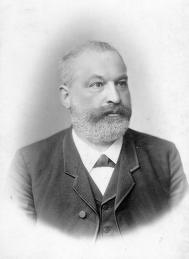Clemens Winkler facts for kids
Clemens Alexander Winkler (born December 26, 1838 – died October 8, 1904) was a German chemist. He is famous for discovering the element germanium in 1886. This discovery helped prove that Dmitri Mendeleev's idea of the periodic table was correct.
Contents
Life of Clemens Winkler
Clemens Winkler was born in 1838 in Freiberg, which was part of the Kingdom of Saxony at the time. His father was also a chemist who had studied with a famous scientist named Berzelius.
Winkler went to school in Freiberg, Dresden, and Chemnitz. In 1857, he started studying at the Freiberg University of Mining and Technology. He was already very good at analytical chemistry, even better than some of what was being taught there.
Many years later, in 1873, Winkler became a professor at the same university. He taught chemical technology and analytical chemistry. In 1892, he was chosen to be a member of the Royal Swedish Academy of Sciences.
In 1893, Winkler moved to Hamburg and married Tanja Braun, who he had known since childhood. He stopped teaching in 1902. Two years later, in 1904, he passed away in Dresden at the age of 65 due to an illness.
Besides being a brilliant scientist, Winkler also had other talents. He enjoyed writing poetry and could play several musical instruments.
Discovering Germanium
In 1886, Winkler received a new mineral from a mine near Freiberg called Himmelsfürst. This mineral was named argyrodite. Other chemists had found that argyrodite contained silver and sulfur.
When Winkler carefully analyzed the mineral, he noticed something strange. The known parts of the mineral only added up to about 93% or 94% of its total weight. This made him think that a new, unknown element must be hiding inside.
Winkler spent several months working to purify the mineral. Finally, on February 6, 1886, he successfully isolated a pure, new element. He named it germanium and quickly shared his discovery with the world. We now know that argyrodite is a special type of sulfide with the formula GeS2 · 4Ag2S.
Germanium and the Periodic Table
After Winkler discovered germanium, scientists wanted to know where it fit in the periodic table. Dmitri Mendeleev, who created the periodic table, thought germanium might be an element he had predicted earlier called "ekacadmium."
However, another scientist named Lothar Meyer believed germanium was actually "ekasilicon," a different element Mendeleev had predicted. To find out who was right, Winkler worked to get more pure germanium. He then measured its physical and chemical properties.
Winkler's results clearly showed that Meyer was correct. Almost all the properties of the new element matched what Mendeleev had predicted for ekasilicon. This close match was very important. It showed how useful and powerful the periodic table and the idea of "periodicity" (repeating patterns of elements) truly were.
Other Scientific Work
Besides finding germanium, Winkler also studied how to analyze gases. In 1884, he published a book about it called Handbook of Technical Gas Analysis. In this book, he described his invention of the three-way stopcock, a special valve used in chemistry.
Winkler also thought about the existence of silicon monoxide (SiO). In 1890, he tried to create it by heating silica with silicon. However, he couldn't get his furnace hot enough, so no reaction happened. Because of this, Winkler incorrectly concluded that SiO did not exist.
Three years earlier, another chemist, C. F. Maybery, had reported forming SiO by reducing silica with charcoal. Later, about 15 years after Winkler's attempt, an engineer named Henry Noel Potter tried Winkler's experiment again. Potter used an electric furnace, which could reach much higher temperatures. This allowed him to successfully create and observe silicon monoxide.
See also
 In Spanish: Clemens Winkler para niños
In Spanish: Clemens Winkler para niños
- German inventors and discoverers


